‘Go for Stack’: Bragg Companies hauls iconic space shuttle to California Science Center
April 30, 2024
In the crane and transport industry, monumental projects are common place. But every now and then, a standout job comes along. It’s a job you will never forget. You feel a sense of pride when it comes to mind. You might even get goose bumps.
 On the evening of January 29, 2024, the shrink-wrapped Endeavour began its last flight. Lifted by its nose, it was upended and set using Bragg’s Liebherr 1750/2 crawler crane. Endeavour was lifted over the structure of the new building and then lowered into position for attachment to the external tank. PHOTOGRAPHY: SANDRA GARCIA FOR BRAGG COMPANIES
On the evening of January 29, 2024, the shrink-wrapped Endeavour began its last flight. Lifted by its nose, it was upended and set using Bragg’s Liebherr 1750/2 crawler crane. Endeavour was lifted over the structure of the new building and then lowered into position for attachment to the external tank. PHOTOGRAPHY: SANDRA GARCIA FOR BRAGG COMPANIES
Such is the case for a recent “dream job” in Los Angeles.
It all started in 1992, (well before the U.S. Space Shuttle program ended in 2011) when a plan was developed to expand the California Science Center by adding an air and space center.
“We knew that some day they would retire the Space Shuttle program,” said Jeffrey Rudolph, president and CEO of the California Science Center. “That’s when our dream began.”
Some 30 years later, that dream is becoming a reality, thanks to the hard work of a huge team of people who look to the sky and smile when they talk about “Go for Stack.” The dream come true for the California Science Center is the new Samuel Oschin Air and Space Center that will feature the Space Shuttle Endeavour in a realistic vertical launch configuration.
The Endeavour spent 11 years temporarily displayed in a horizontal configuration as the Science Center secured funding and prepared for the air and space center. American Cranes & Transport readers may remember the job stories we featured in 2012 moving Endeavour, and then later the external fuel tank, through the streets of Los Angeles. Sarens and Emmert International completed those heavy hauls.
Ready to roll
Fast forward to July 2023 when the building that will house the exhibit was finally ready for the Endeavour, the solid rocket boosters (SRBs) and external tank (ET) to be installed. Rudolph said an “incredible team” was assembled for the project, headed by former NASA contractor Dennis Jenkins, who was involved in all 135 shuttle missions and has a second career tending to retired shuttles.
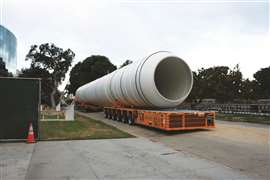 In July 2023, Bragg’s team transported the aft skirts, solid rocket boosters and external tank from a storage facility to the California Science Center in Los Angeles.
In July 2023, Bragg’s team transported the aft skirts, solid rocket boosters and external tank from a storage facility to the California Science Center in Los Angeles.
“When NASA started preparing to launch a shuttle they called it ‘Go for Stack,’” Rudolph explained. “We adopted the same language and process that NASA used in the Vehicle Assembly Building at Kennedy Space Center.”
Actually, the process was a bit different because the bridge cranes and other specially designed lifting and rigging equipment used to stack the shuttle in the launch pad configuration are no longer available.
“It was not an easy process back then, but they had a facility designed for the process,” Rudolph said. “Our team had to work with engineers, riggers and crane operators to figure out how to do this in the open air, in a partially completed building without any of that equipment. Our process involved cranes, rigging gear and scaffolding, improvising and working creatively with the equipment that was available.”
In February of 2022, Long Beach, CA-based Bragg Companies landed the project to erect the exhibit. Bragg is a well-known and respected company in Southern California and beyond, and the company has the fleet of cranes, rigging gear, SPMTs and jacking systems required to seamlessly perform the job.
“Bragg performed engineering and lift planning for this project,” said Justin Lambert, general manager of Bragg Crane & Rigging. “There were approximately 20 engineered plans generated with over 1,500-man hours expended.”
In July 2023, Bragg’s team transported the aft skirts and solid rocket motors from a storage facility in Mojave, CA to the Science Center in Los Angeles. The aft skirts were installed in July 2023 using Bragg’s 825-ton capacity Liebherr 1750/2. The solid rocket motors were put in place in early October 2023, using the same crane plus Bragg’s 190-ton Liebherr LTM-1160 as an assist crane.
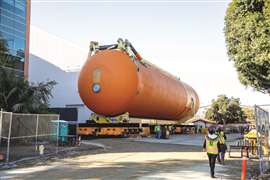 The external tank, known as ET-94, was transported on a Goldhofer SPMT system. Measuring 28 feet in diameter and 154 feet tall, the tank’s fragile outer layer is foam.
The external tank, known as ET-94, was transported on a Goldhofer SPMT system. Measuring 28 feet in diameter and 154 feet tall, the tank’s fragile outer layer is foam.
Precision alignment
Precision was critically important because the SRBs had to be aligned perfectly. Leeway measured 1/16th of an inch.
“When you attach the vertical components that go up 150 feet, they can’t be out of alignment,” said Rudolph. “Instead of the mobile launch platform the actual stack was assembled on, we have a Seismic Isolator, a huge 8-foot piece of concrete that sits on six pedestals so that the shuttle stack can move independently in the event of an earthquake.”
Installation of the aft skirts and the two solid rocket motors was flawless. This was followed by attaching the SRB forward assembly to each motor, also using the Liebherr 1750/2. Then things got more complicated, Lambert said.
ET-94 is a huge orange cylinder that is very fragile. With a diameter of 28 feet and a height of 154 feet, the ET had to be precisely lowered into place in between the two SRBs. It was a hold-your-breath moment in January 2024 when the external tank was carefully placed into its slot with a one-inch clearance.
“The ET had to be threaded down through the scaffold with extreme precision to protect the outer layer of ‘display ready’ foam,” said Lambert.
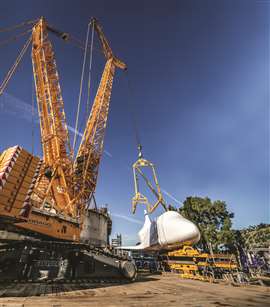 Some 20 engineered lift and transport plans were generated by Bragg Companies’ in-house engineering team.
Some 20 engineered lift and transport plans were generated by Bragg Companies’ in-house engineering team.
Riggers on each corner maneuvered poles in which a block of wood (wrapped in a soft cloth) was attached. They guided the external tank down into the scaffolding, gently pushing and pulling. At one point, in the middle of the night-time operation, work was halted so that the scaffolding could be reconfigured.
“It was fascinating to watch,” Rudolph said. “The team was wonderful. They were amazing at problem solving, and they had a plan for everything. The were very good at dealing with the unexpected.”
Bragg used its 200-ton J&R Engineering Hydraulic Power Rotator to set the ET. This rotator is more compact in size and allowed Bragg to incrementally rotate the ET into position between the two SRBs and the scaffold to aid in the tight tolerance of the mating points.
Final flight
The final and most famous piece of the stack was the priceless Space Shuttle Endeavour, which measured 122 feet long, 59 feet tall and weighed 176,000 pounds. The wingspan was 78 feet wide.
The shuttle was raised and then lowered into place using three cranes – Bragg’s 850-ton capacity Liebherr 1750/2, a 500-ton Liebherr LTM-1400 and a 190-ton Liebherr LTM-1160. The Liebherr 1750/2 was rigged with 1,466,000 pounds of counterweight. Fully rigged it had a tip height of approximately 395 feet and a maximum radius of approximately 151 feet.
The challenges were massive, Lambert said. Jacking up the Endeavour on the South lawn and jacking it down on State Drive was especially complicated.
“We prepared a large ramp for the removal of the Endeavour from the California Science Center Samuel Oschin Pavilion building using large steel jump bridge girders,” Lambert said.
The process involved cutting the shuttle loose from its existing base isolators, jacking the shuttle up to the proper elevation using an Enerpac 110-ton Cube Jack System, introducing a Goldhofer SPMT system for transport out of the Pavilion, lashing the shuttle and transporting it out of the Pavilion, down the ramp and onto the South Lawn.
The jack system was reintroduced to lift the shuttle over 10 feet to allow Bragg’s in-house designed and engineered transportation frames sitting on the SPMTs to walk under the load to prepare for transport. The team then walked the shuttle off the South Lawn in between two existing structures with extremely minimal clearance, and then travelled partially down State Drive. Endeavour was elevated to a certain degree so that one wing could clear over the top of the existing building.
At 9:30 p.m. on the evening of January 29, 2024, Space Shuttle Endeavour – shrink-wrapped for protection – began its last flight. Lifted by its nose, it was upended and set using Bragg’s Liebherr 1750/2 crawler crane and Liebherr LTM 1400 truck crane. Endeavour was lifted over the structure of the new building and then lowered into position for mating with the external tank.
“The most challenging part of the stack was attaching the external tank and the Endeavour,” said Lambert. “The tight tolerances of the mating points were a challenge that required precise alignment.”
Looking back at the project, Lambert said it’s always tough when working in tight spaces handling large hardware. This was especially true during the operations on State Drive, where there was a severe elevation difference between the center of the street and the outer curbs. Another ramp had to be built at the back of the Pavilion for the removal of the Endeavour to the South Lawn using an elaborate layout of large/stacked crane mats and heavy-duty steel grillage mats to make a 62-foot-long ramp.
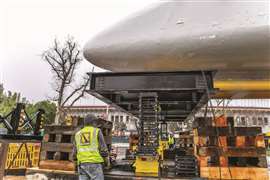 Endeavour was jacked down off the transportation frames using the Enerpac Cube Jacking System. It was transported to the jobsite on Goldhofer SPMTs in preparation for rigging and installation.
Endeavour was jacked down off the transportation frames using the Enerpac Cube Jacking System. It was transported to the jobsite on Goldhofer SPMTs in preparation for rigging and installation.
Attaching and detaching rigging from priceless flight components was a tedious effort, but was executed perfectly. Rigging equipment selection was critical to the success of the job, and when applicable, original NASA equipment was used.
“Bragg’s team refurbished the large yellow vertical sling to lift, upend and trip the Endeavour, just as it was used in a flight assembly campaign at NASA’s facility,” Lambert said. “We also used a 250-ton Hydra-Set that was used during the setting of the Endeavour.
The Hydra-Set allows incremental vertical and rotational movements via separate controls of the crane to aid the tight tolerance alignment of the mating points.”
Additionally, Bragg’s team custom-designed and fabricated two lifting frames that attached to the saddles already attached to the Endeavour. These allowed the Bragg team to safely perform the jacking sequence of the shuttle while maintaining absolute control, as well as level it horizontally and longitudinally.
Safe and sound
Rudolph said safety was considered in every phase of the project.
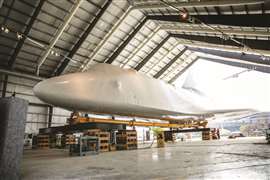 The final and most famous piece of the stack was the priceless Space Shuttle Endeavour, which measures 122 feet long, 59 feet tall and weighs 176,000 pounds. The wingspan is 78 feet wide.
The final and most famous piece of the stack was the priceless Space Shuttle Endeavour, which measures 122 feet long, 59 feet tall and weighs 176,000 pounds. The wingspan is 78 feet wide.
“Safety was considered first in all that was done, safety for the people on the job and safety of the truly irreplaceable national treasure,” said Rudolph.
Bragg Companies President Scott Bragg said the project required specific attention to detail, which the Bragg team kept top of mind through the entire process.
“The level of interest for both the public and the media was huge,” Bragg said. “This was a great benefit but also introduced a more complex environment in terms of safety and focus for our operators. Our safety team went above and beyond to ensure that the job and its spectators were all safe at every turn.”
Bragg also praised the many vendors who supplied equipment for the job, including Goldhofer, Liebherr, Enerpac and J&R Engineering to name a few.
There was a lot of pride in being associated with this project, Rudolph said.
“The U.S. Space Shuttle program is a national pride,” he said. “Californians are especially proud of having the Endeavour in Los Angeles.”
The dream job is still not complete but it’s closer than ever. Rudolph said the exhibit will be open in the next few years.
STAY CONNECTED



Receive the information you need when you need it through our world-leading magazines, newsletters and daily briefings.
CONNECT WITH THE TEAM








